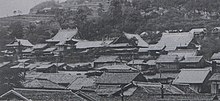Fukusai-ji
| Fukusai-ji Phúc tế chùa | |
|---|---|
 Kannonriding atop aspirit turtle | |
| Religion | |
| Affiliation | Ōbaku |
| Location | |
| Location | 2-56 Chikugomachi,Nagasaki,Nagasaki Prefecture |
| Country | Japan |
| Geographic coordinates | 32°45′13″N129°52′29″E/ 32.75353°N 129.87465°E |
| Architecture | |
| Founder | Kakukai(Juehai) |
| Completed | 1628 |
Fukusai-ji(Phúc tế chùa)is anŌbakuZentemple inNagasaki,Nagasaki,Japan.[1]Its honorarysangōprefix isBunshizan(Phân tím sơn).
History
[edit]
The first temple built in Nagasaki wasKofukuji,built in 1623 by traders from the northern provinces of China, such asJiangsuandZhe gian g.Fukusai-ji, the second temple, was founded in 1628 by members of theNagasaki Chinese community,predominantly merchants from Southern Fu gian and their families.[2]It was built partially in response to the implementation of the anti-Christian motivatedtearuke systemthat required citizens registered to prove their affiliation with a Buddhist temple. Temples would issue certificates that members were not Christian and, because of the long history of Christianity in Nagasaki specifically, the system was first implemented in Kyushu and Kyoto in 1638.[3]The temple was built in part by the desire of the Chinese community to confirm that they were not Christian while maintaining a separate place of worship.[4]The nearbySōfuku-jiwas constructed a few years later by the Northern Fu gian community in 1632.[5][6]
The monkMu'an(Mộc am tính thao,1611-1684), the disciple ofIngen,became the abbot of Fukusai-ji in 1655 and remained in Nagasaki until 1660.[1]
In 1910, themain hallof the temple was designated as aNational Treasure of Japan.The temple was completely destroyed in theatomic bombing of Nagasakion 9 August 1945 at 11:02 am. It was subsequently rebuilt in 1979 with an 18-meteraluminium alloystatue ofKannon,theBodhisattvaof compassion, standing atop aspirit turtle.Inside is aFoucault pendulumwhich swings over the remains of 16,500 Japanese killed duringWorld War IIand in the atomic bombing of the city. At 25 meters, it is one of the largest Foucault pendulums in Japan.[7]
In honor of the victims of the atomic bomb, a bell is rung at 11:02 am each day.[4]
References
[edit]- ^abBaroni, Helen J. (2000-01-01).Obaku Zen: The Emergence of the Third Sect of Zen in Tokugawa Japan.University of Hawaii Press. pp. 32–50.ISBN978-0-8248-2243-9.
- ^Andrade, Tonio; Hang, Xing (2016-03-31).Sea Rovers, Silver, and Samurai: Maritime East Asia in Global History, 1550–1700.University of Hawaii Press. p. 199.ISBN978-0-8248-5277-1.
- ^Tamura, Yoshirō (2000).Japanese Buddhism: a cultural history.Jeffrey Hunter. Tokyo: Kosei Pub. Co.ISBN4-333-01684-3.OCLC45384117.
- ^ab"Fukusai-ji Temple - Nagasaki City, Nagasaki".JapanTravel.Retrieved2022-07-07.
- ^Clulow, Adam (2013-12-24).The Company and the Shogun: The Dutch Encounter with Tokugawa Japan.Columbia University Press. p. 288.ISBN978-0-231-53573-1.
- ^Gunn, Geoffrey C. (2018).World trade systems of the East and the West: Nagasaki and the Asian bullion trade networks.Leiden. p. 174.ISBN978-90-04-35856-0.OCLC1007502712.
{{cite book}}:CS1 maint: location missing publisher (link) - ^"Fukusai-ji Temple".Atlas Obscura.Retrieved2022-07-07.
